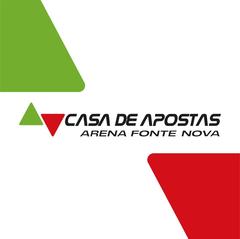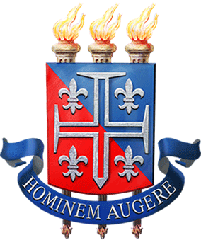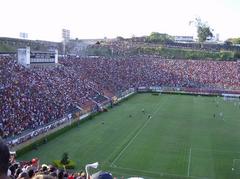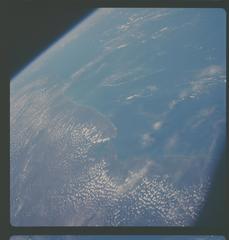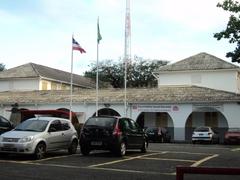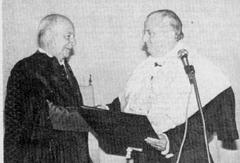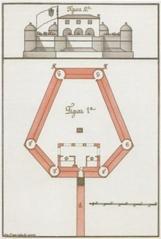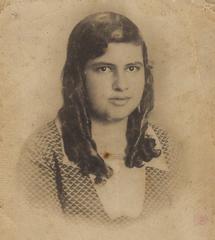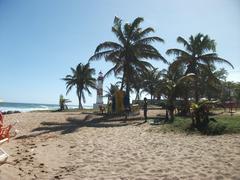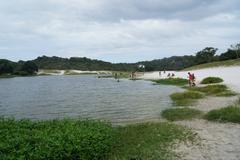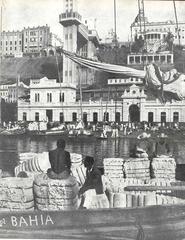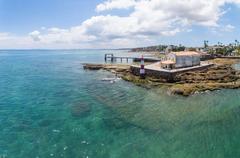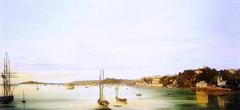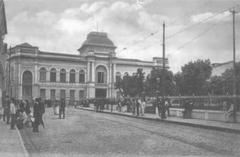Visiting São Francisco Church and Convent, Salvador, Brazil: Tickets, Hours, and Tips
Date: 04/07/2025
Introduction
Nestled in Salvador’s historic Pelourinho district, the São Francisco Church and Convent is one of Brazil’s most celebrated examples of Portuguese colonial heritage and Baroque artistry. Famed for its lavish interiors—featuring over 800 kilograms of gold leaf and more than 55,000 azulejo tiles—this UNESCO World Heritage Site offers an immersive journey through Brazil’s religious, artistic, and social history. Established by the Franciscan Order in the early 18th century, the church complex is a testament to the city’s colonial past and remains a vital religious and cultural landmark (UNESCO, Bahia.ws).
However, visitors should note that a significant structural collapse in February 2025 has led to a temporary closure for safety inspections and restoration. This event highlights the ongoing conservation challenges facing this Baroque masterpiece (IPHAN).
This guide covers the history, architecture, cultural significance, practical visitor information, and recent conservation updates for the São Francisco Church and Convent. Whether you are an art lover, history enthusiast, or cultural traveler, this landmark promises a rich and engaging experience (AFAR).
Table of Contents
- Introduction
- Historical Overview
- Architectural Layout and Features
- Baroque Interiors and Azulejos
- Artistic Furnishings
- UNESCO World Heritage Status
- Conservation and Restoration Efforts
- Visiting Information
- Recent Structural Collapse and Conservation Updates
- Frequently Asked Questions (FAQ)
- Summary and Visitor Tips
- References
Historical Overview
Foundation and Early Development
The São Francisco Church and Convent (Igreja e Convento de São Francisco) was founded in the early 17th century by the Franciscan Order. Construction began in 1708 and continued through the 18th century, establishing the site as a spiritual, educational, and social center at a time when Salvador was the capital of colonial Brazil.
Architectural Evolution and Baroque Flourish
An outstanding example of Baroque architecture in Brazil, the church’s current structure was completed in 1723. Its Baroque elements are evident in the elaborate use of gold leaf, intricate woodwork, and dramatic spatial organization. The lavish interior, one of the most opulent in Latin America, reflects the wealth and religious devotion of colonial Salvador.
Religious and Cultural Significance
Historically, the convent served as more than a place of worship. The Franciscans provided education, charity, and social services, making it a cornerstone of community life. The church’s artwork and iconography—depicting Franciscan saints, Marian themes, and biblical narratives—were designed to inspire and educate a largely illiterate population.
Role in Colonial Society and Urban Development
Strategically located in Pelourinho, the church influenced the development of Salvador’s urban landscape, helping shape the layout of neighboring streets and squares. Its presence solidified the Catholic Church’s spiritual and social authority in the region.
Artistic Heritage and Preservation
The São Francisco complex is famed for its gilded interiors, azulejo panels, and religious artifacts. Recognized and protected by IPHAN, ongoing preservation efforts seek to safeguard this unique heritage (IPHAN).
Architectural Layout and Features
The church distinguishes itself with a rare three-aisled nave, flanked by lateral chapels, a rectangular floor plan, and a main chapel at the eastern end. Influenced by both Franciscan and Jesuit design traditions, its layout includes a choir, sacristy, chapter room, cloisters, library, and conventual quarters. The stone-clad façade, with Mannerist elements, contrasts the interior’s exuberance (Wikipedia, Bahia.ws).
Baroque Interiors and Azulejos
The church’s interior is a Baroque marvel, with approximately 800 kilograms of gold leaf covering carved wood (talha dourada) throughout the nave, chapels, and altars. The main altar is adorned with ornate carvings and ceiling paintings, including a grand depiction of the Glorification of Saint Francis by José Joaquim da Rocha (Trek Zone, Thrillophilia).
A hallmark of the complex is its collection of over 55,000 Portuguese azulejos—the largest in any Latin American church. These blue-and-white tiles, imported from Lisbon in the 18th century, cover the cloisters, corridors, and sacristy. The panels depict both religious and secular themes, offering insight into colonial society and European artistic trends (Wikipedia).
Artistic Furnishings
The sacristy features a monumental cabinet, an ornate lavabo of lioz limestone, and Baroque furniture. The choir and side chapels house intricately gilded altars, while the imported Portuguese organ adds to the atmosphere during services and concerts (Wikipedia).
UNESCO World Heritage Status
In 1985, the São Francisco Church and Convent became part of Salvador’s Historic Centre, designated a UNESCO World Heritage Site for its exceptional universal value and outstanding preservation of Baroque art and architecture (UNESCO). The site represents a fusion of European, African, and Indigenous influences, key to Brazil’s cultural identity.
Conservation and Restoration Efforts
Preservation is an ongoing challenge due to tropical humidity, age, and environmental exposure. IPHAN, in collaboration with the Ministry of Culture and international partners, leads restoration initiatives focusing on structural repairs, gilded woodwork, and tile conservation. Community engagement and sustainable tourism support these efforts (IPHAN, Visit Salvador da Bahia).
Visiting Information
Visiting Hours and Tickets
- Hours: When open, Tuesday to Sunday, 9:00 AM to 5:00 PM; closed on Mondays and select holidays.
- Tickets: Entrance fees range from R$5.00 to R$15.00, with discounts for students, seniors, and children. Free entry on some national holidays. Tickets can be purchased onsite and online via official platforms.
Accessibility and Guided Tours
- The site offers wheelchair access to main areas, though some historic sections may be less accessible.
- Guided tours are available in Portuguese, English, and Spanish; booking in advance is recommended for peak times.
Best Times and Travel Tips
- Early morning weekdays are ideal for avoiding crowds and enjoying the church’s details in a peaceful setting.
- Comfortable footwear is advised due to Pelourinho’s cobblestone streets.
- Nearby attractions include the Cathedral Basilica of Salvador, Largo do Pelourinho, Museu Afro-Brasileiro, Elevador Lacerda, and Mercado Modelo.
Photography and Special Events
- Photography is permitted (no flash or tripods); respect worshippers during services.
- Concerts and cultural events are occasionally held, featuring the historic organ and local musicians.
Recent Structural Collapse and Conservation Updates
On February 5, 2025, a structural collapse in the church’s central nave resulted in one fatality and several injuries, prompting an immediate closure for safety assessments and repairs. The incident highlighted the urgent need for increased conservation resources and preventive measures. Restoration and safety protocols are ongoing, with updates provided through official channels (IPHAN).
Frequently Asked Questions (FAQ)
Q: Is São Francisco Church currently open to visitors?
A: As of July 2025, the church is closed for restoration following a structural collapse. Check official sources for reopening updates.
Q: What are the usual visiting hours and ticket prices?
A: When open, hours are Tuesday–Sunday, 9:00 AM–5:00 PM; tickets cost R$5.00–R$15.00, with discounts available.
Q: Are guided tours available?
A: Yes, in multiple languages; advance booking is recommended.
Q: Is the church accessible to visitors with disabilities?
A: Main areas are wheelchair accessible; some historic sections may have limited access.
Q: Is photography allowed?
A: Yes, but no flash or tripods, and be respectful during religious services.
Summary and Visitor Tips
The São Francisco Church and Convent is a Baroque masterpiece and cultural treasure at the heart of Salvador’s Pelourinho district. Its gilded interiors, azulejo panels, and rich heritage draw visitors from around the world. Recent conservation challenges underscore the importance of responsible tourism and ongoing preservation efforts.
Before visiting, always check the latest updates on opening status, tickets, and guided tours through official channels. Early weekday visits are best to avoid crowds. Enhance your experience by exploring nearby historical sites and supporting local conservation initiatives.
For up-to-date information, immersive tours, and travel tips, download the Audiala app and follow related resources on social media (Audiala). Your engagement helps ensure that this remarkable monument endures for generations.
References
- UNESCO World Heritage Centre
- Bahia.ws
- Instituto do Patrimônio Histórico e Artístico Nacional (IPHAN)
- AFAR
- Wikipedia
- Visit Salvador da Bahia
- Thrillophilia
- Trek Zone
